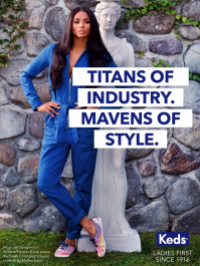This article was published in the August 2016 issue of STORES Magazine.
At 100 years old, Keds is celebrating a major milestone few fashion brands can claim, and Emily Culp is helping the iconic sneaker maker sprint into its next millennium. Culp joined Keds last July as chief marketing officer, responsible for driving strategic development and execution of global marketing initiatives — including retail development, omnichannel marketing, digital, public relations and content.
Prior to joining Keds, she led digital and online marketing teams at Rebecca Minkoff toward a new mobile app and website relaunch. In partnership with eBay, Culp was key in creating the designer’s “connected store” concept for its New York City flagship, which included beacons, RFID technology and interactive mirrors.
Culp’s career has also included leadership roles with Clinique and Unilever; on the agency side, she has more than 10 years’ experience at the helm of brand teams at Ogilvy, Digitas and Arnold.

Emily Culp
Chief Marketing Officer
Keds
Lexington, Mass.
Keds turns 100 this year. What are you doing to celebrate in terms of marketing events, campaigns and new products?
To celebrate the centennial and our heritage as an American brand, we committed to creating a collection of shoes made in the United States. The collection is completely sourced, designed and manufactured in Big Rapids, Mich., and exclusively launched at Barneys on July 1.
We also formed the Keds Collective, which includes eight globally celebrated female creative entrepreneurs from fashion, music, art and technology. Collective members include Allison Williams, Ciara and Tori Kelly, along with Wearable Experiments co-founder Billie Whitehouse, musician and actress Soko, blogger, actress and style icon Jamie Chung and K-pop star Krystal Jung. We think the Collective mirrors the individuality and everyday triumphs of the women in the world who wear our sneakers.
In February we hosted a “Centennial Celebration,” inviting members of the media and influencers to celebrate with us. We had an interactive timeline to tell the brand story with members of the Collective in attendance. One of our major considerations when we planned the centennial celebration was to make sure we both celebrated the past and looked forward to the future. We wanted to celebrate our rich heritage, but the emphasis is on moving the brand forward and innovating for the future.

Female empowerment has become a part of the overall Keds brand. What’s the story behind the story?
Keds was one of the first brands to provide women with accessible, fashionable footwear. Over the last 100 years, powerful and iconic women including Audrey Hepburn, Katherine Hepburn, Marilyn Monroe, Jackie O and Yoko Ono have celebrated the brand.
The idea of female empowerment is rooted in the brand’s heritage and is something we are proud to celebrate through our platform, “Ladies First Since 1916.” We’re launching a “Made in America” collection that is finished by women in the U.S., so it’s pretty clear that we are focused on our customer and what her needs are.
Would you share some insights into how you and your team are developing messages?
Mobile and digital-first marketing is the key to our current strategy and is one of the most significant changes we have made to our strategy over the recent years. We’re all about understanding that we have mere seconds with our customer — as her attention span continues to shrink, content must reflect this change.
Micro-content has been crucial in order to effectively engage with our customers, so we’re creating micro-videos where she can see 25 different ways to style and wear our products. The key is to ensure content can be meaningful as a standalone “chapter” and even more impactful as a “book,” when the consumer engages with multiple brand touchpoints. Much like a publisher, we’re actually developing an editorial style for our brand and about how we continue to effectively integrate content and commerce.
Has the growth of mobile made an impact on the data you track?
The metrics we track are predominantly the same but what has shifted is the weighting of certain metrics. To put that in context, we’re closely monitoring market share to e-commerce revenue growth and database growth in customer relationship management metrics. On the qualitative side, we follow our brand awareness and sentiment scores.
As for social media, I am not fixated on the number of our fans or followers, but instead on the engagement level we have with each. We also look at editorial coverage. Again, it’s not being fixated on impressions, but more on the quality and relevance to our target customers.
Mobile conversion was once minimally used as a brand health proxy, and now I would argue it is one of the leading metrics.
"Brands must do everything they can to continue to innovate and meet the expectations of its consumers and deliver value."
Emily Culp
Keds
What are some challenges you see before the retail industry in connecting with customers?
Omnichannel marketing is a delicate balance. Brands need to consider the complete consumer experience and make sure those experiences are seamless from channel to channel. Consumers are able to engage with brands in so many diverse ways, and brands need to keep this top of mind.
Given the advancement mobile and social media have provided to the retail experience, consumers’ expectations of brands are higher than ever. Brands must do everything they can to continue to innovate and meet the expectations of its consumers and deliver value.
Marketers are also faced with the challenge of extracting data and finding a way to view it holistically to discover patterns and insights. Unlocking the data for various silos allows us to make smarter decisions. We must understand the customer decision-making journey, anticipate their questions and have the right content wherever they might be looking for it, so we can interact.
Even with only crumbs of data, we can get a better idea of how customers are engaging with us. From there, we can market to them in a valuable way.